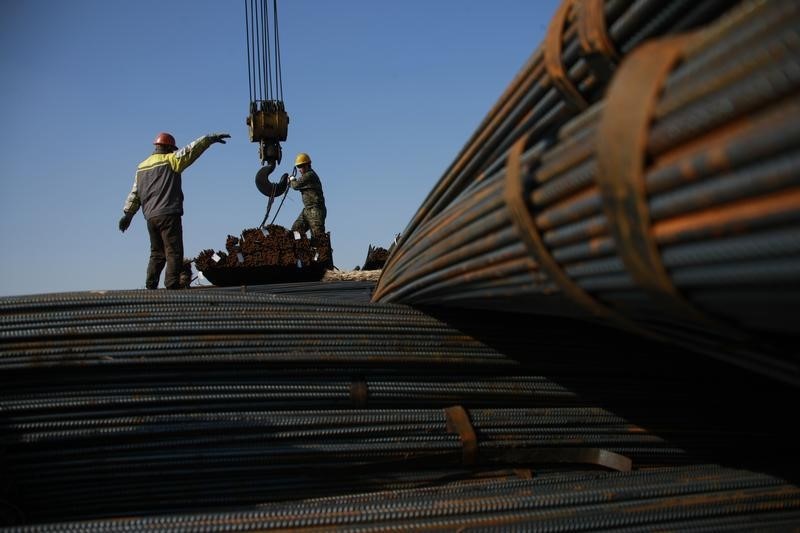MANILA, Jan 7 (Reuters) - Steel consumption in Southeast
Asia's six biggest economies is estimated to have declined as
much as 8.7% last year due to pandemic-driven lockdowns, and
prospects for a quick rebound remain clouded, an industry group
said on Thursday.
As the economies of Indonesia, Malaysia, Philippines,
Singapore, Thailand and Vietnam were hit hard by the global
health crisis, the region's steel consumption likely slumped to
between 73.3 million tonnes and 75.3 million tonnes, according
to the South East Asia Iron and Steel Institute (SEAISI).
The estimates are 6.2%-8.7% lower than the 2019 volume, it
said in a report.
Construction activity, traditionally the main driver of
steel demand in the region, was disrupted in Indonesia, Malaysia
and the Philippines. In contrast, Vietnam was able to expand in
the sector, having been able to quickly curb the coronavirus
spread, the group said.
Thailand has also taken immediate action by boldly driving
the demand for construction in the second and third quarters, it
said.
The automotive industry was also a "major victim" among the
region's steel consumers, with the largest producing countries
Thailand, Indonesia and Malaysia severely hit, while the
manufacturing sector also took heavy blows, it said.
But not all is bad during the economic downturn, as the
region's steel producers opted to boost exports to countries
that had controlled the pandemic and restarted their economies
much earlier, notably China, while domestic demand remains
sluggish.
Southeast Asia's steel exports jumped 27% to 9.3 million
tonnes in the first half of 2020 from a year earlier, according
to SEAISI.
With COVID-19 restrictions still in place, the group said
activity in the region's construction sector and infrastructure
expansion remains limited.
"With collapsing domestic demand for steel, steel industries
are facing the urgent need for new market opportunities outside
the region to withstand the economic downturn," the group said.
- English (USA)
- English (UK)
- English (India)
- English (Canada)
- English (Australia)
- English (South Africa)
- English (Nigeria)
- Deutsch
- Español (España)
- Español (México)
- Français
- Italiano
- Nederlands
- Português (Portugal)
- Polski
- Português (Brasil)
- Русский
- Türkçe
- العربية
- Ελληνικά
- Svenska
- Suomi
- עברית
- 日本語
- 한국어
- 简体中文
- 繁體中文
- Bahasa Indonesia
- Bahasa Melayu
- ไทย
- Tiếng Việt
- हिंदी
Pandemic-hit Southeast Asia's 2020 steel consumption down 6.2%-8.7% - industry group
Published 01/07/2021, 10:27 AM
Updated 01/07/2021, 10:30 AM
Pandemic-hit Southeast Asia's 2020 steel consumption down 6.2%-8.7% - industry group

Latest comments
Install Our App
Risk Disclosure: Trading in financial instruments and/or cryptocurrencies involves high risks including the risk of losing some, or all, of your investment amount, and may not be suitable for all investors. Prices of cryptocurrencies are extremely volatile and may be affected by external factors such as financial, regulatory or political events. Trading on margin increases the financial risks.
Before deciding to trade in financial instrument or cryptocurrencies you should be fully informed of the risks and costs associated with trading the financial markets, carefully consider your investment objectives, level of experience, and risk appetite, and seek professional advice where needed.
Fusion Media would like to remind you that the data contained in this website is not necessarily real-time nor accurate. The data and prices on the website are not necessarily provided by any market or exchange, but may be provided by market makers, and so prices may not be accurate and may differ from the actual price at any given market, meaning prices are indicative and not appropriate for trading purposes. Fusion Media and any provider of the data contained in this website will not accept liability for any loss or damage as a result of your trading, or your reliance on the information contained within this website.
It is prohibited to use, store, reproduce, display, modify, transmit or distribute the data contained in this website without the explicit prior written permission of Fusion Media and/or the data provider. All intellectual property rights are reserved by the providers and/or the exchange providing the data contained in this website.
Fusion Media may be compensated by the advertisers that appear on the website, based on your interaction with the advertisements or advertisers.
Before deciding to trade in financial instrument or cryptocurrencies you should be fully informed of the risks and costs associated with trading the financial markets, carefully consider your investment objectives, level of experience, and risk appetite, and seek professional advice where needed.
Fusion Media would like to remind you that the data contained in this website is not necessarily real-time nor accurate. The data and prices on the website are not necessarily provided by any market or exchange, but may be provided by market makers, and so prices may not be accurate and may differ from the actual price at any given market, meaning prices are indicative and not appropriate for trading purposes. Fusion Media and any provider of the data contained in this website will not accept liability for any loss or damage as a result of your trading, or your reliance on the information contained within this website.
It is prohibited to use, store, reproduce, display, modify, transmit or distribute the data contained in this website without the explicit prior written permission of Fusion Media and/or the data provider. All intellectual property rights are reserved by the providers and/or the exchange providing the data contained in this website.
Fusion Media may be compensated by the advertisers that appear on the website, based on your interaction with the advertisements or advertisers.
© 2007-2025 - Fusion Media Limited. All Rights Reserved.